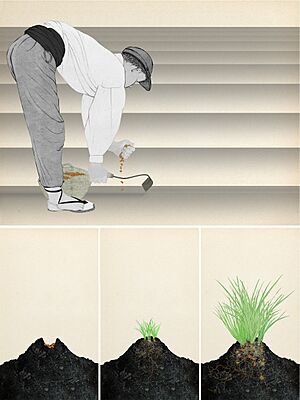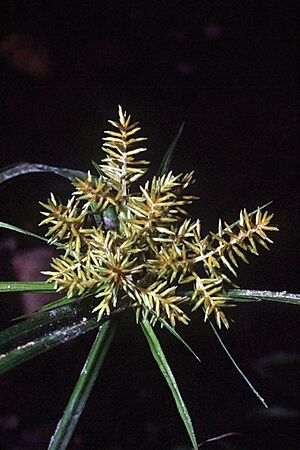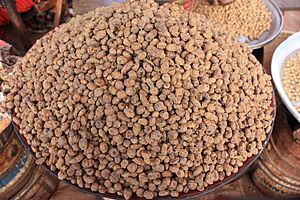Chufa sedge facts for kids
Quick facts for kids Chufa sedge |
|
|---|---|
 |
|
| Scientific classification | |
| Genus: |
Cyperus
|
| Species: |
esculentus
|
Cyperus esculentus is a plant known by many names, like chufa, tiger nut, atadwe, yellow nutsedge, and earth almond. It belongs to the sedge family and grows in many parts of the world. You can find it in places like Southern Europe, Africa, Madagascar, the Middle East, and India.
People grow C. esculentus for its tasty tubers. These tubers are called earth almonds or tiger nuts. They get the name "tiger nut" because of the stripes on their skin and their hard shell. They are eaten as a snack or used to make horchata de chufa. This is a sweet, milk-like drink.
Cyperus esculentus can grow wild, as a weed, or as a crop. Sometimes, it spreads to new areas where it isn't native. When this happens, it can become an invasive species. In many countries, C. esculentus is seen as a weed. It often grows in wet places like rice paddies and peanut farms. You might also find it in well-watered lawns and golf courses when the weather is warm.
Contents
What is Chufa Sedge?
Chufa sedge is a plant that can live for one year (an annual plant) or many years (a perennial plant). It can grow up to about 3 feet (90 cm) tall. Each plant has single stems that grow from a tuber.
This plant spreads in a few ways: by seeds, by underground stems called rhizomes, and by its tubers. Because it can create many copies of itself, chufa sedge can quickly take over disturbed soil. Its stems are shaped like triangles. The slender leaves are about 0.1 to 0.4 inches (3 to 10 mm) wide.
The plant's flower clusters, called spikelets, are easy to spot. They have flat, oval seeds surrounded by four leaf-like parts called bracts. These bracts hang down and are positioned at 90 degrees from each other. The spikelets are 0.2 to 1.2 inches (5 to 30 mm) long. They are narrow with pointed tips and have 8 to 35 small flowers. Their color can be straw-colored or gold-brown. One plant can make up to 2,420 seeds. The leaves of the plant are very tough and fibrous. People often mistake them for grass.
The roots of chufa sedge are a large and complex system. They have fine, fibrous roots and scaly rhizomes. Small, hard, round tubers and basal bulbs are attached to these roots.
The tubers are about 0.1 to 1 inch (0.3 to 2.5 cm) wide. They can be yellow, brown, or black. A single plant can produce hundreds or even thousands of tubers in one growing season. When it gets cold, the leaves, roots, rhizomes, and basal bulbs die. But the tubers survive underground. They will sprout again the next spring when the soil temperature stays above 43°F (6°C). These tubers can stay alive for several years.
When the tubers sprout, many rhizomes grow. These end in a basal bulb near the soil surface. These basal bulbs then grow into stems and leaves above ground. Fibrous roots grow underground. Chufa sedge is pollinated by wind. It needs cross-pollination because it cannot pollinate itself.
Spotting Similar Plants
- Sedges (Cyperus) have leaves that look like grass. They are similar in appearance. You can mostly tell them apart from grasses by their triangular stems.
- Purple nutsedge (C. rotundus) is another weedy sedge. It looks a lot like yellow nutsedge (C. esculentus). These two sedges are hard to tell apart. They can even grow in the same spot. Some differences are that purple nutsedge has purple spikelets. Its tubers often grow in groups, not just one at the tip. Also, purple nutsedge tubers taste bitter, unlike the mild, almond-like flavor of C. esculentus.
Where Does Chufa Sedge Grow?
C. esculentus is a plant that spreads easily. It is very invasive in Oceania, Mexico, parts of the United States, and the Caribbean. It mainly spreads by its seeds. This plant can easily be moved from one country to another. It can also adapt to many different climates and soil types. In Japan, it is an unwanted weed that grows well in wet areas.
Growing Chufa Sedge
C. esculentus is grown in many countries. These include Spain, Nigeria, the United States, Guatemala, Mexico, Chile, Brazil, and many others in the Middle East and Africa. In these places, chufa is mostly used as animal feed or as a side dish. But in Hispanic countries, it is mainly used to make horchata. This is a sweet, milk-like drink.

Ideal Growing Conditions
Chufa sedge needs a mild climate to grow well. Cold temperatures, shade, and low light can stop it from flowering. Tubers will not start to grow if there is too much nitrogen, long daylight hours, or high levels of a plant hormone called gibberellic acid. Flowers start to grow when there are 12 to 14 hours of daylight each day.
Tubers can grow in soil up to about 12 inches (30 cm) deep. But most of them are found in the top layer of soil. Chufa sedge can handle tough soil conditions. This includes periods of dry weather and floods. The tubers can even survive soil temperatures around 23°F (-5°C). They grow best in sandy, moist soils with a pH between 5.0 and 7.5. The most chufa sedge plants are often found in low, wet areas. They do not grow well in salty soil.
Planting and Harvesting
Chufa is usually planted in flat fields that have been tilled. Ridges are made to help with watering. Seeds are planted by hand on these ridges, which are about 2 feet (60 cm) apart. The distance between seeds can be 6 to 8 inches (15 to 20 cm). Seeds are planted about 3 inches (8 cm) deep. A typical amount of chufa planted is about 107 pounds of tubers per acre (120 kg/ha).
Chufa is planted between April and May. It needs to be watered every week until harvest in November and December. Tubers start to grow about 6 to 8 weeks after the seedlings appear. They grow quickly during July and August. The plants are ready to harvest in about 90 to 110 days. On average, a field can produce between 10 and 19 tons per hectare.
Chufa Sedge as a Weed
Once chufa sedge starts growing, it is very hard to get rid of completely. This is because its root system has many layers. Tubers and roots are connected down to 14 inches (36 cm) or more. The tubers are connected by thin roots that break easily when pulled. This makes it hard to remove the whole root system. Underground stems (rhizomes) can grow up to 2 feet (60 cm) long. The plant can quickly grow back if even one tuber is left in the ground.
Chufa sedge competes with other plants for light, water, and nutrients. This can make nearby plants weaker. It can grow into a thick patch. These patches can spread by more than 3 feet (1 meter) per year. Tubers and seeds spread through farming activities, soil movement, water, and wind. They are often found mixed in with crop seeds.
When chufa plants are small, they are hard to tell apart from other weeds. This makes it difficult to find them early and stop them from spreading. Once detected, people use different methods to control C. esculentus. These include mechanical removal, pulling them by hand, grazing animals, damping, and using herbicides.
Harvest and Drying Process
Harvesting usually happens in November or December. The leaves are burned during harvest. A combine harvester pulls the tiger nuts out of the ground. Right after harvesting, the tiger nuts are washed with water. This removes sand and small stones.
Drying usually happens in the sun and can take up to three months. The temperature and humidity must be watched very carefully during this time. The tiger nuts need to be turned every day to dry evenly. The drying process helps them last longer. It stops them from rotting or getting bacterial infections. This keeps their quality and high nutrition levels.
Some problems with drying are that the nuts can shrink, their skin can wrinkle, and they can become very hard.
Storing Chufa Nuts
Tiger nuts lose a lot of water when they are dried and stored. The amount of starch in the tubers goes down during storage. But the amount of reducing sugar (invert sugar) goes up. Dried tiger nuts can be stored dry. They can be rehydrated by soaking them without losing their crisp texture. Soaking is often done overnight. Dried tiger nuts are hard. Soaking them makes them easier to eat and gives them a better texture.
According to the Consejo Regulador de Chufa de Valencia (a group that ensures the quality of Valencia's Tiger Nuts), 100 ml of Spanish horchata de chufas has about 66 kcal of energy. It has about 0.5 g of protein, over 10 g of carbohydrates (with at least 1.9 g of starch), and at least 2 g of fats.
What Are Chufa Nuts Used For?
Dried tiger nuts have a smooth, tender, sweet, and nutty taste. You can eat them raw, roasted, dried, or baked. They are also used to make tiger nut milk, other tiger nut drinks, or oil.
Chufa Drinks
In Spain, the drink now called horchata de chufa is the original form of horchata. In West African countries like Nigeria and Mali, it's called kunun aya. It is made from tiger nuts that have been soaked, ground, and sweetened with sugar and water. Researchers at the University of Ilorin say that kunu made from tiger nuts is a cheap source of protein.
Horchata de chufa is still popular in Spain. A special council makes sure the product is high quality and can be traced back to its origin. It is served ice-cold as a refreshing summer drink. Often, it comes with fartons, which are long, sweet pastries. Horchata de chufa is also used by people who cannot drink dairy milk because they are lactose intolerant.
Most of the tiger nuts grown in Spain are used to make horchata de chufa. Alboraya is the most important place for its production.
The tubers can also be roasted and ground to make a coffee substitute.
Chufa as Food
The tubers are edible raw or cooked. They have a slightly sweet, nutty flavor. This is different from the more bitter-tasting tuber of the related Cyperus rotundus (purple nutsedge). Tiger nuts are quite hard. They are usually soaked in water before eating. This makes them much softer and gives them a better texture. They are a popular snack in West Africa. The tubers can also be dried and ground into flour.
In Northern Nigeria, tiger nuts are called aya. They are usually eaten fresh. Sometimes, they are dried and then rehydrated and eaten. A popular snack among the Hausa children of Northern Nigeria is made by toasting the nuts and coating them with sugar. Also, a drink called kunun aya is made by processing the nuts with dates. It is then strained and served chilled.
In Egypt, tiger nuts are known as Hab el-Aziz. After soaking them in water to soften them, they are sold as street food from hand carts. Their popularity was even shown in movies, like the song named after them: Hab el Aziz.
Flour from roasted tiger nuts is sometimes added to biscuits and other baked goods. It is also used to make oil, soap, and starch extracts. It is used in making nougat, jam, and beer. It can flavor ice cream and is used in preparing kunu. Kunu is a non-alcoholic drink usually made from grains like millet or sorghum. It is heated and mixed with spices and sugar. Tiger nuts are a good substitute for grains to improve the nutritional value of kunu.
Tiger nut oil can be used naturally with salads or for deep frying. It is thought to be a high-quality oil. Tiger nut "milk" has been tried as a different source of milk for fermented products, like yogurt. It can be helpful for people who cannot drink milk because they are lactose intolerant.
Chufa Oil
The tubers of C. esculentus contain 20-36% oil. Because of this, it has been suggested as a possible crop for making biodiesel. One study found that chufa produced about 1.5 metric tons of oil per hectare (174 gallons per acre). This was based on a tuber yield of 5.67 tons per hectare and an oil content of 26.4%. Another study over six years found tuber yields from 4.02 to 6.75 tons per hectare. The average oil content was 26.5%, and the average oil yield was 1.47 tons per hectare. The oil from the tuber has 18% saturated fatty acids (like palmitic acid and stearic acid) and 82% unsaturated fatty acids (like oleic acid and linoleic acid).
Chufa for Fishing
In the UK, boiled tiger nuts are used as bait for carp. The nuts must be prepared in a specific way to avoid harming the fish. They are soaked in water for 24 hours. Then, they are boiled for 20 minutes or longer until they are fully expanded. Some fishermen let the boiled nuts ferment for 24–48 hours. This can make them more effective. If the nuts are not prepared correctly, they can be harmful to carp.
There was a famous carp named Benson that weighed 54 kg (120 lb). It was found dead in a fishing lake, with an empty bag of unprepared tiger nuts nearby. People first thought tiger nut poisoning caused its death. However, an examination by a taxidermist concluded that the fish died naturally.
A Look Back: Chufa Through History
Some people believe that an ancient human relative called Paranthropus boisei (also known as the "Nutcracker Man") ate a lot of tiger nuts.
C. esculentus was one of the oldest plants grown by people in prehistoric times and Ancient Egypt. It was a very important food. Wild chufa roots have been found at Wadi Kubbaniya, north of Aswan. These roots date back to around 16,000 BC. Dry tubers also appear later in tombs from the Predynastic period, around 3000 BC.
During that time, C. esculentus tubers were eaten in different ways. They were boiled in beer, roasted, or made into sweets with ground tubers and honey. The tubers were also used as medicine. They could be eaten, used as an ointment, or as an enema. They were also burned to make homes or clothes smell sweet.
Chufa continued to be an important food during the Dynastic period. The plant was grown only in Egypt. The tomb of the vizier Rekhmire from the 15th century BCE shows farmers preparing and measuring tiger nuts. They made votive cakes from them as offerings to the god Amun. The modern name for tiger nuts in Egypt is حب العزيز (Hab el Aziz). This means "grains of Al-Aziz", named after the Fatimid ruler who supposedly loved them.
See also
 In Spanish: Chufa para niños
In Spanish: Chufa para niños




